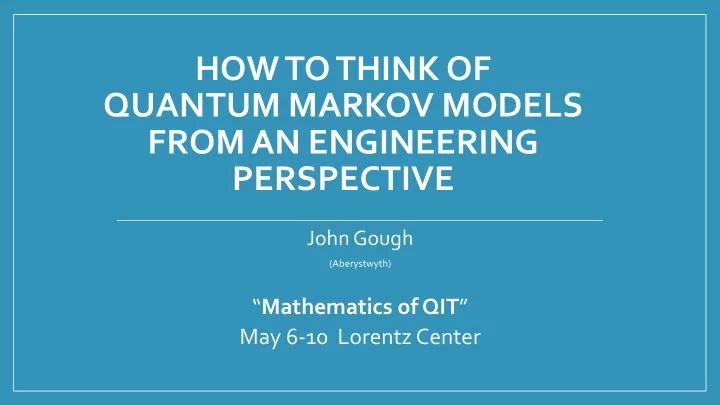

HOW TO THINK OF QUANTUM MARKOV MODELS FROM AN ENGINEERING PERSPECTIVE John Gough (Aberystwyth) “ Mathematics of QIT ” May 6-10 Lorentz Center
Input-Plant-Output Models • Plant = System (state variable x ) • Laplace domain • Transfer Function
Block Diagrams • Series • Feedback
Fractional Linear Transformations • “Open Loop” • “Closed Loop”
Fractional Linear Transformation • The feedback reduction • Algebraic loops if
Double Pass! • Special case of feedback reduction
Networks and Feedback Control • Measurement Based Feedback Control • Coherent Feedback Control
Quantum Inputs and Outputs Lamb Model / Caldeira-Leggett / Ford-Kac-Mazur / Thirring-Schwabl /Lewis-Maassen/ Yurke-Denker
Non-Markov Models and Markov Limits Input-output relations Spectral Density Gardiner-Collett
Quantum Markovian Dynamics • A semi-group of CP identity-preserving maps (Heisenberg picture!) • Generator (Lindblad) • Dilation auxiliary space , vector state , unitary on
Quantum Input-Output Systems Hudson-Parthasarathy (1984) V.P. Belavkin (1979+) Gardiner-Collett (1985)
Quantum Input Processes The “wires” are quantum fields! • Field quanta of type k annihilated at the system at time t : • Hilbert Space: • Default state is the (Fock) vacuum
Quantum Stochastic Models Single input – Emission/Absorption Interaction • Wick-ordered form: • Heisenberg Picture • GKS-LindbladGenerator • Input-Output Relations
Quantum Stochastic Models • Two inputs – pure scattering Wick-ordered form: Heisenberg Picture Input-Output Relations
Quantum Ito Table • Fundamental Processes • Table • Product Rule
SLH Formalism • Hamiltonian H • Coupling/Collapse Operators L • Scattering Operator S
Quantum Stochastic Models • General ( S ,L , H ) case Wick-ordered form: Or better as a QSDE (quantum Ito stochastic calculus)
Quantum Stochastic Models Heisenberg Picture Lindblad Generator Input-Output Relations
This is Markovian! “Pyramidal” Multi -time Expectations In non- Markovian models there is no “state” in the usual sense!
Quantum Networks • How to connect models? • Cascaded models • Algebraic loops • Feedback Control
The Series Product
Perturbations (Avron, Fraas, Graf) • Virtual displacement of the model Displacements Virtual work
Local Asymptotic Normality • Suppose that the QMS has a unique faithful stationary state • (CCR) Algebra of fluctuations (Guta and Kiukas, Bouten) • Geometric structure closely related to the Series Product! • General perturbations (Bouten and JG) • PROBLEM: is this some form of de Bruijn identity?
Network Rule # 1 Open loop systems in parallel
Network Rule # 2 Feedback Reduction Formula
The Network Rules are implemented in a workflow capture package QHDL QHDL (MabuchiLab) N. Tezak, et al., (2012) Phil. Trans. Roy. Soc. A, 370, 5270.
Transfer Operator • Classical Transfer function • SLH version • Properties
Adiabatic Elimination • An important model simplification split the systems into slow and fast subspaces • Mathematical this is also a fractional linear transformation • It commutes with feedback reduction! • JG, H. Nurdin, S. Wildfeuer, J. Math. Phys., 51, 123518 (2010); H. Nurdin, JG, Phil. Trans. R. Soc., A 370, 5422-36 (2012)
Measurement • Homodyne • Compatibility • Filter Conditioned state Innovations
Coherent Quantum Feedback Control
Autonomous Quantum Error Correction
Thank You For Your Attention,
Recommend
More recommend